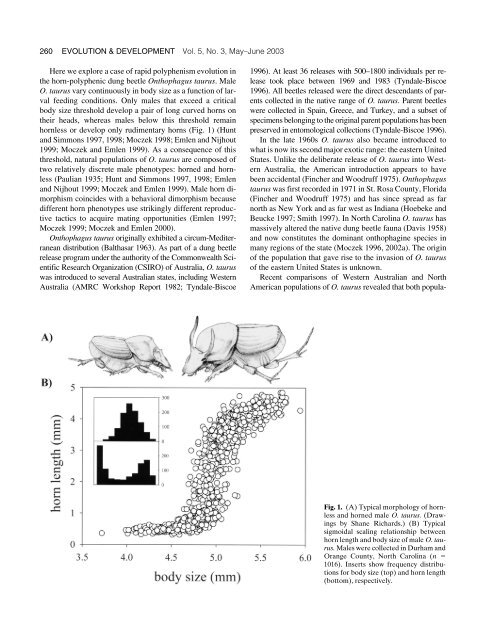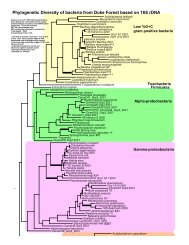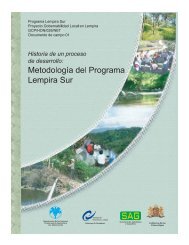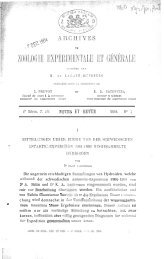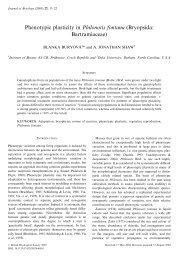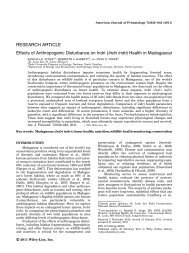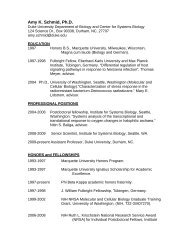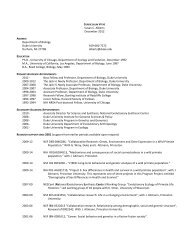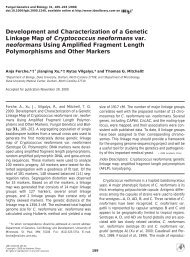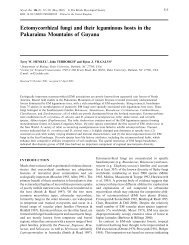Rapid evolution of a polyphenic threshold - Duke Biology - Duke ...
Rapid evolution of a polyphenic threshold - Duke Biology - Duke ...
Rapid evolution of a polyphenic threshold - Duke Biology - Duke ...
You also want an ePaper? Increase the reach of your titles
YUMPU automatically turns print PDFs into web optimized ePapers that Google loves.
260 EVOLUTION & DEVELOPMENT<br />
Vol. 5, No. 3, May–June 2003<br />
Here we explore a case <strong>of</strong> rapid polyphenism <strong>evolution</strong> in<br />
the horn-<strong>polyphenic</strong> dung beetle Onthophagus taurus.<br />
Male<br />
O. taurus vary continuously in body size as a function <strong>of</strong> larval<br />
feeding conditions. Only males that exceed a critical<br />
body size <strong>threshold</strong> develop a pair <strong>of</strong> long curved horns on<br />
their heads, whereas males below this <strong>threshold</strong> remain<br />
hornless or develop only rudimentary horns (Fig. 1) (Hunt<br />
and Simmons 1997, 1998; Moczek 1998; Emlen and Nijhout<br />
1999; Moczek and Emlen 1999). As a consequence <strong>of</strong> this<br />
<strong>threshold</strong>, natural populations <strong>of</strong> O. taurus are composed <strong>of</strong><br />
two relatively discrete male phenotypes: horned and hornless<br />
(Paulian 1935; Hunt and Simmons 1997, 1998; Emlen<br />
and Nijhout 1999; Moczek and Emlen 1999). Male horn dimorphism<br />
coincides with a behavioral dimorphism because<br />
different horn phenotypes use strikingly different reproductive<br />
tactics to acquire mating opportunities (Emlen 1997;<br />
Moczek 1999; Moczek and Emlen 2000).<br />
Onthophagus taurus originally exhibited a circum-Mediterranean<br />
distribution (Balthasar 1963). As part <strong>of</strong> a dung beetle<br />
release program under the authority <strong>of</strong> the Commonwealth Scientific<br />
Research Organization (CSIRO) <strong>of</strong> Australia, O. taurus<br />
was introduced to several Australian states, including Western<br />
Australia (AMRC Workshop Report 1982; Tyndale-Biscoe<br />
1996). At least 36 releases with 500–1800 individuals per release<br />
took place between 1969 and 1983 (Tyndale-Biscoe<br />
1996). All beetles released were the direct descendants <strong>of</strong> parents<br />
collected in the native range <strong>of</strong> O. taurus.<br />
Parent beetles<br />
were collected in Spain, Greece, and Turkey, and a subset <strong>of</strong><br />
specimens belonging to the original parent populations has been<br />
preserved in entomological collections (Tyndale-Biscoe 1996).<br />
In the late 1960s O. taurus also became introduced to<br />
what is now its second major exotic range: the eastern United<br />
States. Unlike the deliberate release <strong>of</strong> O. taurus into Western<br />
Australia, the American introduction appears to have<br />
been accidental (Fincher and Woodruff 1975). Onthophagus<br />
taurus was first recorded in 1971 in St. Rosa County, Florida<br />
(Fincher and Woodruff 1975) and has since spread as far<br />
north as New York and as far west as Indiana (Hoebeke and<br />
Beucke 1997; Smith 1997). In North Carolina O. taurus has<br />
massively altered the native dung beetle fauna (Davis 1958)<br />
and now constitutes the dominant onthophagine species in<br />
many regions <strong>of</strong> the state (Moczek 1996, 2002a). The origin<br />
<strong>of</strong> the population that gave rise to the invasion <strong>of</strong> O. taurus<br />
<strong>of</strong> the eastern United States is unknown.<br />
Recent comparisons <strong>of</strong> Western Australian and North<br />
American populations <strong>of</strong> O. taurus revealed that both popula-<br />
Fig. 1. (A) Typical morphology <strong>of</strong> hornless<br />
and horned male O. taurus. (Drawings<br />
by Shane Richards.) (B) Typical<br />
sigmoidal scaling relationship between<br />
horn length and body size <strong>of</strong> male O. taurus.<br />
Males were collected in Durham and<br />
Orange County, North Carolina (n �<br />
1016). Inserts show frequency distributions<br />
for body size (top) and horn length<br />
(bottom), respectively.


